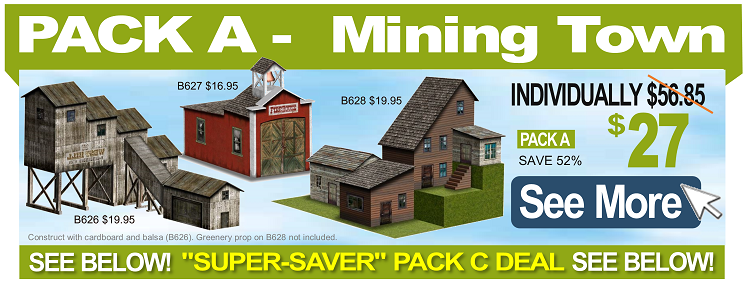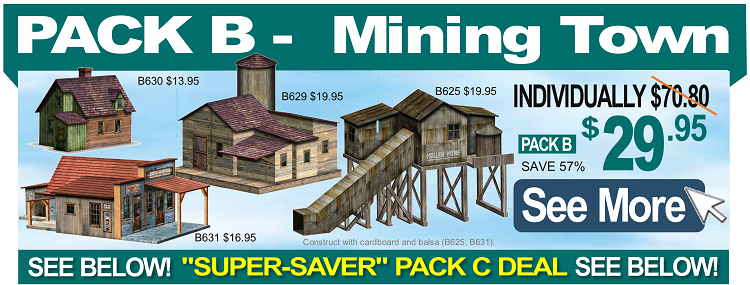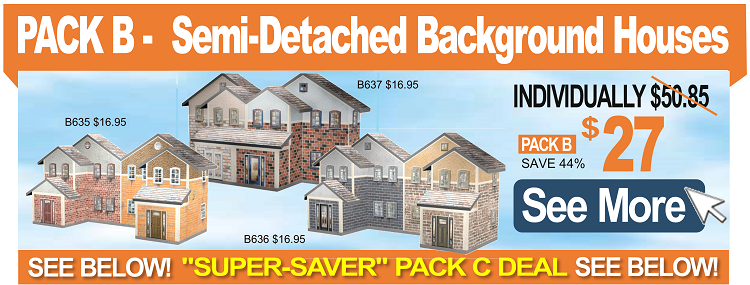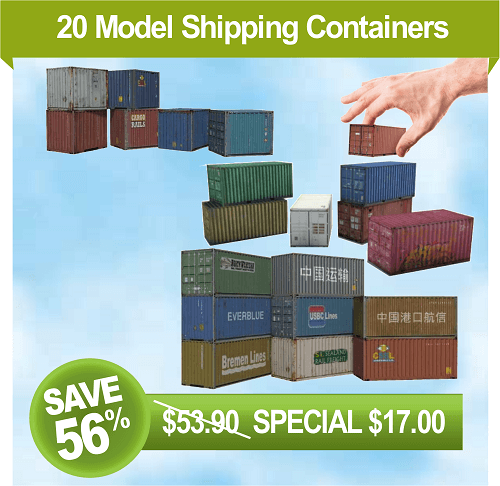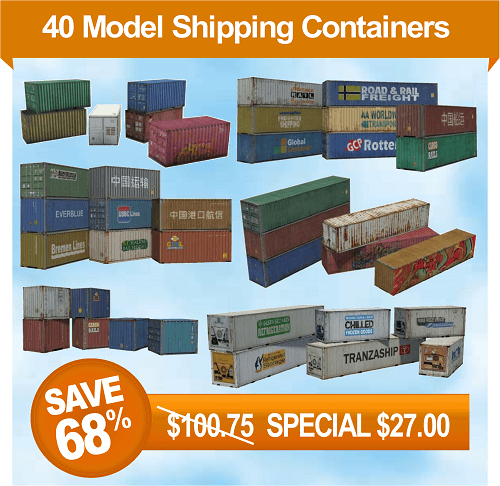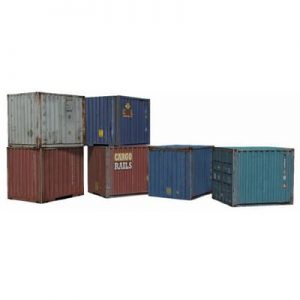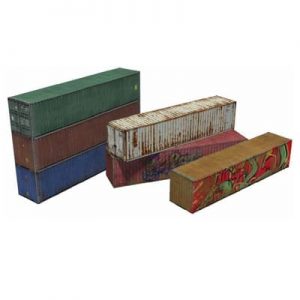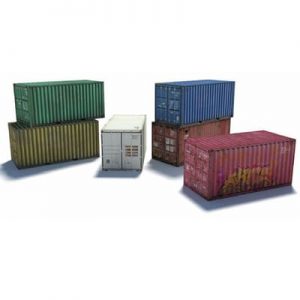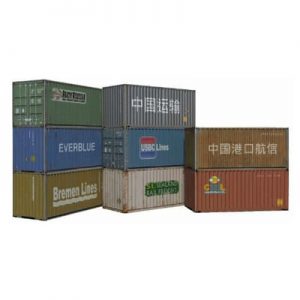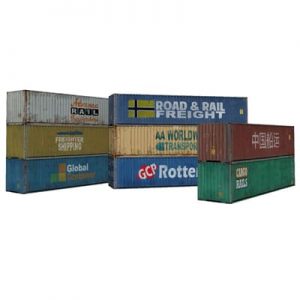Download 40 Printable Shipping Container Models for N Scale, OO Gauge, and HO Scale Model Railroads.
Shipping containers are something you see in the strangest place at times. Sometimes they are used as a shed on farm, or as storage units at a public self-storage facility. The most common places to see containers stacked high is at a port or alongside a railway yard ready for loading onto trains. It is not uncommon to see double header locomotives hauling flat cars laden with shipping containers sometimes two high. That’s why scale model shipping containers are so popular with model railroaders. They look right at home on trains, in industrial yards, and just placed alongside track on N scale, OO gauge, and HO scale model railroads.
The other thing about intermodal shipping containers is they come in a variety of colors, and they vary greatly in condition. Some are old and rusty after being exposed to plenty of salt spray from being stacked on cargo ships as they cross the high seas. Others are just dirty and scratched. That’s the beauty of them, unless they are fresh out of a factory, most intermodal containers show signs of use and exposure to the elements (particularly salt spray). They get a hard life, but a very durable and take the rough treatment. Although the 40 printable paper model shipping containers in this series are not made of heavy galvanized steel, they are still really sturdy for their HO scale size. N scale paper plans are also for sale.
[expander_maker id=”1″ more=”Load more” less=”Load less”]Intermodal shipping containers are increasingly popular for home construction and as storage units in household storage facilities. They are not only strong, but also very secure making it difficult for criminals to break in and steal the contents. Another advantage is that real full-sized shipping containers offer excellent protection from the elements – sun, water, wind, humidity etc.
At modelbuildings.org you get 40 different printable shipping container models – each a different color and in a different state of repair. Some are even painted with grafitti. Some of the paper model shipping containers have refrigeration motors on the end, and most are branded with the names of shipping companies to add to the authentic look of the download scale models.
Just download the paper PDF plans, print out the plans on your printer, glue each intermodal container onto cardboard before cutting the parts out and gluing them together. All 40 paper model shipping containers are easy to construct and so real looking. There’s nothing preventing you from making several of each container, as long as you don’t breach copyright regulations which basically say you can’t sell, trade, or give away the PDF file to anyone else. Being able to construct multiple scale model containers is a huge saving as most model railroaders want several to position on trains, in loading yards, alongside warehouses and factories, at ports, on trucks, and even a few trackside to resemble a real life like scene. To buy 40 plastic model shipping containers would be pricey, and if you needed more you would need to fork out money to buy more plastic models. By comparison you download the PDF paper files just once and print as many copies as you require personally. So you don’t need to pay for additional downloads, or even pay for postage and handling. The downloading is very quick so mo waiting by the mailbox. Also, the printable model shipping containers are more realistic than plastic models and don’t require painting or weathering.
You’ll enjoy constructing these 40 paper model shipping containers and you will be impressed with the end look. With the special deal above you get all 40 shipping container models to download for a SPECIAL BULK DISCOUNT PRICE!
More about containerization
Using shipping containers for transporting and storing cargo is basically called containerization. In general terms it is an arrangement of multi-purpose cargo transport utilizing multi-purpose lockers (commonly called shipping containers and ISO containers).
The compartments have standard dimensions. Intermodal containers can be stacked and emptied, stacked, shipped proficiently over long distances on land or sea, and moved starting with one method of vehicle then onto the next – containerized ships, rail transport flatcars, and semi-trailer trucks… all without being opened. The security framework is totally automated from cranes and specialized forklift trucks. All shipping containers are individually numbered and followed by computer tracking.
On an HO scale model railroad much of the enjoyment and satisfaction for the scale model is in tracking the movements of the paper model shipping containers they have personally made. They might have the container start its journey at a factory in an industrial district and be transported by lorry to a rail yard for loading onto the flat-cars of trains. The trains would then transport the cargo to a port or another factory where it would be unloaded and loaded onto a ship or left on the wharf waiting to be loaded aboard a containerized ship. The whole process becomes so real it is easy to forget that the HO scaled-down paper model shipping containers are miniaturized printed versions of real full-sized intermodal containers. The model railroader can become absorbed in the process of transportation and forget that the shipping containers and trains are actually HO scale models.
Containerization in one form or another first started a few centuries prior however was not generally used until after World War II. Post war it significantly diminished the expenses of transport and became a critical accelerator in globalization. Containerization got rid of the manual handling of most shipments and the requirement for long periods of warehousing. It meant to end of employment for a huge number of dock laborers who in the handling boxed and wrapped cargo. Containerization likewise decreased blockage in ports, fundamentally shortening transporting times and thefts and pilfering of cargo in transit.
Prior to containerization, products were normally dealt with physically as part of a bulk cargo load. It was usual for merchandise to be stacked onto a vehicle from the manufacturing plant and taken to a port distribution center where it would be offloaded and stored inside or outside a warehouse waiting the next vessel. That’s where a lot of stealing took place. Loads were not as secure in those days compared to storage in the modern containerization we have today. At the point when the vessel arrived, the cargo would be moved to the side of the ship alongside other freight to be transported or conveyed into the hold and moved by dock laborers. The ship might have called at a few different ports before off-loading a given cargo. Cargo would sometimes be physically handled and stored several times before arriving at its final destination. The freight may have been offloaded at several ports or distribution centers before reaching its ultimate destination. The whole process made transporting cargo very expensive, tedious and unreliable. Thefts and damage to freight was common and added to the cost of transportation.
A rail modeler might want to replicate the old way of transporting goods by adding cranes and boxed loads to his or her HO scale train layout, or they might prefer to use scale model shipping containers to transport cargo instead, or possibly a mix of both systems. That’s the advantage of building a miniaturized version of real life situations and systems in HO scale, or OO gauge for those in the UK, or N scale for those modelers working to an even smaller size. Downloading and printing your own paper model shipping containers to the scale of your choice allows for a great deal of flexibility.
Its thought that containerization has its birthplace in early coal mining districts in England starting in the late eighteenth century. In 1766 James Brindley planned the crating of a vessel with 10 wooden compartments to move coal from Worsley Delph Quarry to Manchester via the Bridgewater Canal.
Containerization hugely reduced the cost of global transportation and improved the speed of delivery from one port to another and then on to trucks or trains to the final destination.
The impacts of containerization quickly spread and no longer just involved shipping companies and ports in the transportation business. Trucking and rail transport companies got involved in containerized freight transport not limited to ocean transport.
Improved cargo security is likewise a significant advantage of containerization. When the freight is stacked into a shipping container, it isn’t touched again until it arrives at its destination, unless it it inspected by customs or bio-security on arrival at a port or point of entry into a different country. The cargo isn’t easily seen or accessible to the casual onlooker so is less likely to be stolen.
Intermodal containers have also become mainstream for the dispatch and transport of private autos and different vehicles around the country and world utilizing 20 foot or 40 foot sealed shipping containers.
That’s a brief history of how transport systems operated and how containerization developed around the world. Transport freight is a big part of modern society so it makes sense for a railway modeler to replicate the systems and procedures on their HO scale model railroad. Constructing paper model shipping containers to replicate their full real sized counterparts is an excellent way to go about it. The PDF paper models are downloadable and printable to OO gauge (for UK modelers), or to HO scale or N scale. The paper plans are downloaded over the internet, printed out, and constructed utilizing cardstock or carboard from old cereal packages. The designs of these printable shipping container models are in full color and resemble real full-sized intermodal containers even down to having photographic replicas of refrigerated motors on the end of some containers in the series. Once constructed the HO scale model shipping containers can be stacked on flatcars, trucks, or stored at warehouses, factories, or ports ready for transportation by rail, road or sea. Model railroader scenery relies on realism to be convincing to the eye, and nothing is more realistic than these HO scale paper models (also available for OO scale as well as N scale).
[/expander_maker]

